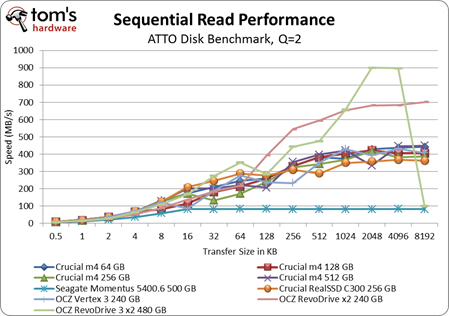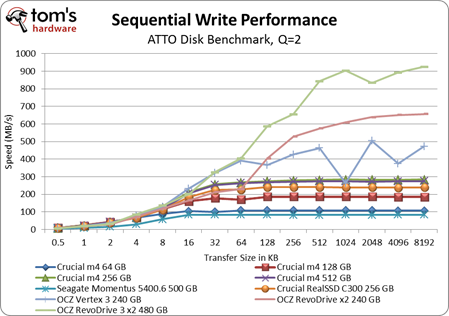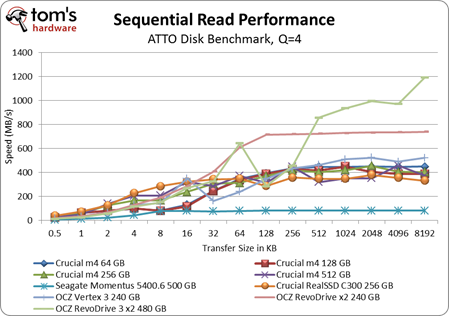The OCZ RevoDrive 3 X2 Preview: Second-Gen SandForce Goes PCIe
Sequential Performance Versus Transfer Size
Alright, so that was 128 KB sequential performance in Iometer with the RevoDrive 3 X2 operating on data with a queue depth of one. As we've already established, though, that's not the type of environment this product is intended to address. If you're shopping for a PCI Express-based SSD, it's because you need unparalleled throughput, and you have a workload able to tax the storage subsystem with a higher number of outstanding requests.
This time we'll use ATTO to test the sequential reads/writes over 2 GB using a queue depth of two. Why only a queue depth of two? Even when you're pushing the envelope, operations complete so much faster on an SSD that queue depths higher than two or three are far less common on an average desktop.
The other reason to use ATTO is its ability to easily test different transfer sizes. While 128 KB is the standard block size for measuring sequential performance, there are situations where you're going to deal with smaller or larger transfer sizes. Think about executables or video files. The block sizes are often larger than 1 MB. On the lower end of the spectrum, DLLs and file dependencies are often 4 KB or less.
Using a queue depth of two, there's very little performance difference between the RevoDrive 3 X2 and other SSDs at smaller transfer sizes. In fact, in some cases, the RevoDrive X2 actually outpaces the RevoDrive 3 X2 at 128 KB, 256 KB, and 512 KB. The RevoDrive 3 X2 doesn't hold a commanding lead until you get to transfer sizes above 1 MB.
Sequential write performance is a little better. Once you move up to transfer sizes above 64 KB, the RevoDrive 3 X2 holds a commanding lead every step of the way. At 1 MB, you're looking at an amazing sequential write speed of 900 MB/s.
Turning up the queue depth to four gives us a different look at performance. The RevoDrive 3 X2 offers slower performance at lower transfer sizes and at 128 KB, but at transfer sizes above 256 KB, you're pushing sequential read speeds in excess of 1 GB/s.
In sequential writes, the RevoDrive 3 X2 still suffers at lower transfer sizes. However, you only need a 64 KB transfer to see throughput close to 1 GB/s.
Get Tom's Hardware's best news and in-depth reviews, straight to your inbox.
Current page: Sequential Performance Versus Transfer Size
Prev Page 128 KB Sequential Performance Next Page PCMark 7: Storage Suite-
warmon6 ReplyIt's not a business-class product. It's for the power user who is able to tax it using the right workload. If you're not one of those folks, the RevoDrive 3 X2 is seriously overkill.
OVERKILL?!?!
Nothing is overkill in the computer arena in terms of performance. :p
Just the price can be over kill. o.0 -
acku Santa is going to need a bigger expense account... :)Reply
Personally, I'm hoping that OCZ adds TRIM prior to September.
Cheers,
Andrew Ku
TomsHardware.com -
greenrider02 I saw defense of the Vertex 3's occasional low numbers, but no mention of the solid (and sometimes better) performance that the cheaper and more miserly Crucial m4 showed throughout your tests.Reply
Perhaps you have some bias towards the Vertex 3 that needs reconsideration?
Other than that, $700 seems like a fair price when considering the performace difference, especially if utilized properly, for instance as a high traffic web/corporate server -
acku greenrider02I saw defense of the Vertex 3's occasional low numbers, but no mention of the solid (and sometimes better) performance that the cheaper and more miserly Crucial m4 showed throughout your tests.Perhaps you have some bias towards the Vertex 3 that needs reconsideration?Other than that, $700 seems like a fair price when considering the performace difference, especially if utilized properly, for instance as a high traffic web/corporate serverReply
If you read the first page then you know that I give a nod to Vertex 3s as the fastest MLC based 2.5" SSD. I consider that plenty of love. :).
We'll discuss the lower capacity m4s in another article. FYI, I suggest that you read page 5 and page 6. We are not testing FOB. We are testing steady state. That's part of the reason the SF-based drives are behaving differently with incompressible data.
On your second point, this is in no way targeted toward an enterprise environment (that's what Z-drives are for). There is no redundancy in the array if a single SF controller fails. The whole card is a dud afterward. You can add higher level redundancy, but enterprise customers have so far been nervous on SandForce products. Plus, there's a general preference for hardware vs. software redundancy. (That's them talking not me). Overall, this makes it unacceptable for any enterprise class workload.



